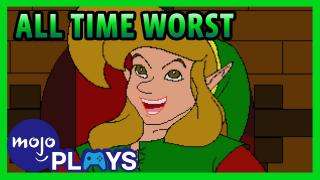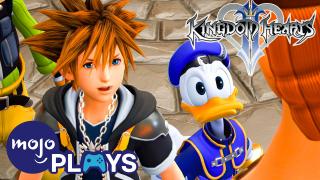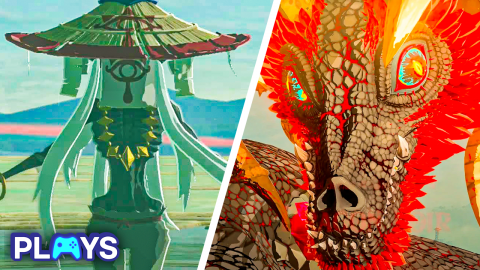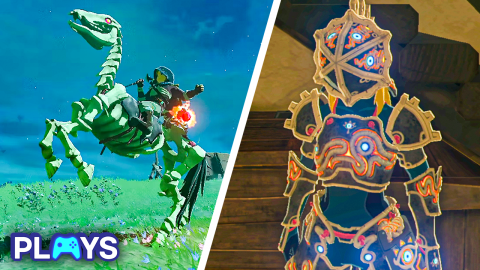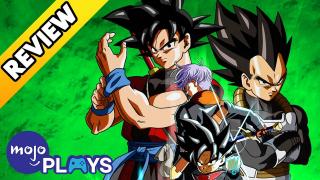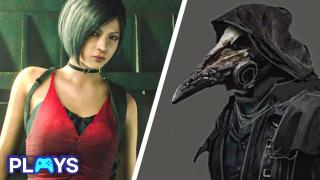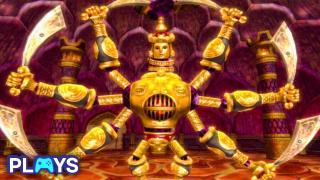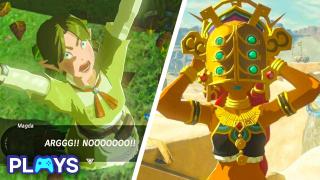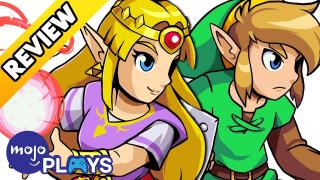The Best Song From Every Zelda Game
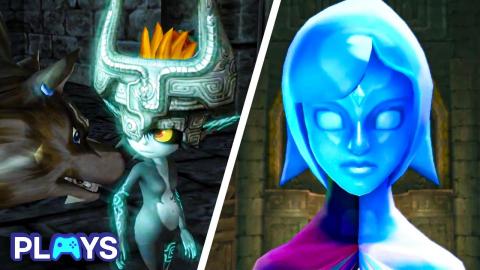
“Overworld Theme”
“The Legend of Zelda” (1987) Well, it really couldn’t be anything else. The original game in the series only has a handful of tracks, and the iconic overworld theme is undeniably the best one. Impressively composed by Koji Kondo in just one day, it’s the perfect adventure theme. The way the notes climb and descend throughout the melody is so incredibly catchy, players were undoubtedly humming along as they vanquished monsters and uncovered secrets. It’s a good thing Kondo is such a musical genius; the theme has been reworked and reused throughout multiple entries, becoming the overall theme of the series. And that’s made it one of the most recognizable pieces of music in gaming.
“Palace Theme”
“Zelda II: The Adventure of Link” (1988) We’ll admit a lot of us heard this awesome tune on the Temple stage in “Super Smash Bros. Melee” first. But it is just as remarkable in its original incarnation, if not more so due to the older hardware. It plays in every Palace, or Temple, in the game, save for the final one. It’s much more complex than the Dungeon Theme from the original game, and honestly more memorable. It captures the feeling of exploring a mystical location, being both fun to hum along to and offering a distinct feeling of danger. Since “Zelda II’s” enemies and dungeons are some of the franchise’s toughest, it fits very well.
“Dark World Theme”
7 Times Dark Souls Infiltrated Other Games
“The Legend of Zelda: A Link to the Past” (1992) When Link was first transported into the Dark World for the first time, it blew players' minds. Suddenly, the size of the map had doubled, literally splitting the game between light and dark. Part of what helped this new area stand out was its theme. It was upbeat like Hyrule’s overworld theme, yet it was injected with a certain forlornness that made for a more moody atmosphere. The simulated short horn notes and snare bounce you long while the drawn out strings provide the main melody. It made us want to stay in the Dark World not just to progress through the game, but so that we could keep jamming to this awesome theme.
“Tal Tal Heights”
The Absolute WORST ZELDA Game?
“The Legend of Zelda: Link’s Awakening” (1993) The Tal Tal Heights region in “Link’s Awakening” is the last major area of the map you’ll visit before completing the game. Thankfully, it has a fantastic theme to carry you through its final challenges. At first, you might think it’s another reworked version of the classic Overworld theme as it includes the opening notes. But then it bursts into something different, bringing more energy than any other track in the game. It’s so lively and adventurous, it’s hard not to just stand there and listen to it. When “Link’s Awakening” was remastered with an entirely redone soundtrack, we couldn’t wait to hear how this tune was updated. And it did not disappoint.
“Title Theme”
Why Kingdom Hearts III is the Most Anticipated Title of 2019
“The Legend of Zelda: Ocarina of Time” (1998) “Ocarina of Time” genuinely has one of the best title cards in gaming history. However, we doubt it would be as memorable without Koji Kondo’s beautiful, emotionally stirring theme. As a lonesome Link rides his steed across Hyrule Field, deep piano notes and haunting strings hint that the game will be far more impactful and mature than those that came before it. Of course, it’s the main melody, naturally delivered by an ocarina, that gives the track its flair. It takes the few simple notes of the Recorder in the original game and turns them into something both majestic and tragic. More often than not, we’d let the entire sequence play out before hopping back in just so we could listen to this.
“Stone Tower Temple”
“The Legend of Zelda: Majora’s Mask” (2000) We’ve gushed several times about how incredible and layered the Stone Tower Temple Theme from “Majora’s Mask” is. Forgive us for gushing some more. It’s a great slow build, beginning with understated percussion before disturbing, moaning vocals join in. Then comes the bass and ocarina, somehow both clashing with the other two parts in their playfulness and going hand-in-hand when creating the somber tone of the dungeon. It’s spooky, yet melodic; unsettling, yet snappy. This makes it not only a great dungeon theme by “Zelda” standards, but representative of Ikana Canyon, the land plagued by spirits and undead that the Stone Tower is found in. Although it isn’t quite as good, it’s still cool that the theme changes instruments after the tower is flipped.
“The Tower Top Floor”
The HARDEST Boss Fight From Every Zelda Game
“The Legend of Zelda: Oracle of Ages” (2001) To be honest, there aren’t a ton of memorable new tracks in “Oracle of Ages,” at least compared with most others in the series. Thankfully, the theme for your final section before you reach the big bad, Veran, is appropriately sinister. You’ll hear this during the top section of Veran’s lair, the Black Tower. The high notes are punctuated by well-timed bass, and the whole vibe never fails to unease us. It’s a great track for putting players on edge. This section is a maze of staircases that lead to different rooms, most of which are frustratingly small spaces with annoying enemies in them. A track that hints at peril at every turn deserves some recognition.
“Dancing Dragon Dungeon”
“The Legend of Zelda: Oracle of Seasons” (2001) Yeah, with a track this catchy, it’s no wonder the dragon is dancing. The fourth dungeon in the game is a mine located in Mt. Cucco. And while you might expect an abandoned mine full of monsters to feature a dark or depressing theme, this one only makes us want to get up and groove. Actually, it’s a little bit distracting. We’d be trying to solve a puzzle or figure out where to go. All the while, this absolute banger would instinctively make us bob our heads and imitate its main hook. It’s far and away the best dungeon theme across both “Oracle” games.
“Sea of Trees”
20 Hidden Secrets in Zelda Tears of the Kingdom
“The Legend of Zelda: Four Swords” (2002) As you’d probably expect from a tacked on multiplayer mode for the GBA re-release of “A Link to the Past,” there isn’t much to the soundtrack of “Four Swords.” Players navigate your three basic Nintendo level types, with the forest area’s music being our favorite. Unlike many other themes heard in wooded areas of past entries, the Sea of Trees sounds less mystical and whimsical, and more dangerous and foreboding. It's a dense place said to be easy to get lost in with a surprising variety of enemies like Moldorms, Eyegores, and Moblins. So perhaps a more tense theme was called for.
“Dragon Roost Island”
Super Dragon Ball Heroes: World Mission Review
“The Legend of Zelda: The Wind Waker” (2003) In some “Zelda” soundtracks, there’s a clear best choice while in others, the choice is much harder. “Wind Waker” is of the latter. But in the end, the theme for Dragon Roost Island is too good and too iconic to deny. The home of the first full dungeon and the Rito, a brand new race to the series, obviously needed to hook players. While there’s nothing wrong with the island itself, and its inhabitants are engaging, it’s the music that truly gets the job done. The castanet-like percussion and the strums of a stringed instrument provide the backdrop while the flute-like melody whisks you away. It’s no surprise that it’s a favorite amongst fans.
“Village of the Blue Maiden”
10 Predictions For Resident Evil Village DLC
“The Legend of Zelda: Four Swords Adventures” (2004) The multiplayer games tend to focus on combat and puzzle solving rather than exploration, story, or characters. However, in “Four Swords Adventures,” you’ll come across the Village of the Blue Maiden, a level comprised of NPCs rather than enemies. Yet, its theme is still a little unnerving and dark. Marimba-like percussion and chimes keep rhythm, while a spooky flute, horns, and strings make up the melody. Funnily enough, the melody comes from the Kakariko Village theme, though it’s played in a minor key here. It’s interesting how a small change in key can turn something that usually sounds happy into something more menacing.
“Temple of Droplets”
The Best Temple From Every Zelda Game
“The Legend of Zelda: The Minish Cap” (2005) Some dungeon themes are melodious, others capture their atmosphere. The great ones can do both. “The Minish Cap’s” fourth dungeon, the Temple of Droplets, is mostly frozen over. Link must solve puzzles to get certain portions to melt. While ice levels are usually annoying, we must commend this one’s theme for legitimately sounding like a frozen, lonesome cave. Seriously, it even uses sleigh bells as its percussion. The slow, drawn out strings that play over top are evocative, projecting feelings of isolation and peril. Despite this, it’s still a pleasant melody that had us whistling along. The notes hit with such power, it’s a shame this theme has never been remastered.
“Midna’s Lament”
“The Legend of Zelda: Twilight Princess” (2006) There are few songs throughout “The Legend of Zelda” that can invoke anguish in fans the way “Midna’s Lament” can. After getting struck down by Zant, Midna clings to life as Link races to get her to Zelda. The lower piano notes move at a quick pace, highlighting the urgency of the situation, while the higher notes provide the sorrowful melody. Strings eventually join, tugging at your heart while Link navigates the enemy-infested sewers of Hyrule Castle. “Twilight Princess” is the most cinematic entry in the series, with music being used to help establish key scenes and characters. This moment was already stressful, but the harrowing music made it even more so.
“Linebeck’s Theme”
“The Legend of Zelda: Phantom Hourglass” (2007) From the moment you meet Linebeck in “Phantom Hourglass,” it’s clear he’s no hero. Trapped by spikes in the Temple of the Ocean King, he asks for Link’s help and lies about having an injured ankle. He’s shown throughout to be selfish and cowardly, and that’s partially why we love his theme so much. The blusterous march almost sounds cocky, projecting confidence just as Linebeck attempts to. Its percussion gives it a certain bounce while the horns sound triumphant and the harpsichord gives it a bit of elegance. It seems like we should respect the person this theme belongs to. But having it linked to Linebeck gives the already solid theme a touch of silliness that we admire.
“Realm Overworld”
“The Legend of Zelda: Spirit Tracks” (2009) The DS installments don’t get nearly as much love as other “Zelda” games. Some of that is understandable, but the soundtrack for “Spirit Tracks” is actually pretty strong. For example, it has one of the best overworld themes in the series. The rhythm of the upbeat percussion matches with the noise of Link’s train. The use of the pan flute is a nice nod to Link using one throughout the game. And just in case you couldn’t tell, it’s catchy as hell. The flute’s main melody will undoubtedly get stuck in your head every time you hop in your train. And the accompanying strings, whether they’re simulating a guitar or something more orchestral, are delightful.
“Thank You”
The 10 BEST Zelda Breath of the Wild Side Quests
“The Legend of Zelda: Skyward Sword” (2011) Fi got a lot of flack when “Skyward Sword” released, but there was one thing no one could deny: she had a beautiful theme. The soft strings and flute combined for something that was mysterious, peaceful, and ethereal. However, that theme was made significantly sadder when it came time to say goodbye to Fi. As the spirit prepared to sleep within the Master Sword for eternity, she took one final moment to thank Link. Their connection allowed her to feel things for the first time, notably happiness. Her theme was stripped down, with the main notes being played ever so delicately on the piano before the strings joined. This was a goodbye we would not soon forget.
“Lorule Castle”
“The Legend of Zelda: A Link Between Worlds” (2013) The music for the final challenge in “A Link Between Worlds” may be the best dungeon theme in the entire franchise. The tense strings will instantly put you on edge while the main flute melody dances along playfully. Once you reach a new floor, the true genius of the theme begins to unveil itself. Every time you climb higher, new instruments join the fray, until what was once a mere snappy tune booms around you. Dungeons will usually signal progression through harder challenges and enemies without the music changing. But using musical cues, and ones that sound awesome at that, makes Lorule Castle much more memorable.
“Riverside”
“The Legend of Zelda: Tri Force Heroes” (2015) Many of the tracks in “Tri Force Heroes” are upbeat, happy, and filled with adventure to match the light-hearted nature of its plot and gameplay. However, “Riverside” stands out from the group. Once you reach the second area, you’ll be greeted by something much more serene. What sounds like a marimba keeps the beat, almost sounding like deep water droplets to match with the environment. A single violin cries over top before being joined by more strings and woodwinds, concocting a genuinely gorgeous composition. It sort of seems like it doesn’t belong in this game; it’s such a pretty, peaceful melody, we’d expect to hear it alongside one of the more bolder entries.
“Hyrule Castle”
Cadence Of Hyrule Review: Zelda Games Get Rhythm
“The Legend of Zelda: Breath of the Wild” (2017) Like “Wind Waker,” it was hard to narrow down the best track in “Breath of the Wild.” There are so many peaceful, swooning tracks that accompany its gorgeous landscapes. However, the “Hyrule Castle” theme perfectly encapsulates the climax of this specific adventure. The woodwinds, organ, and piano all blend to make something subtly unnerving, but not thrilling; dangerous, yet downplayed. The use of organ calls back to Ganondorf’s appearance in “Ocarina of Time,” itself a reworking of his classic theme from “A Link to the Past.” Notes from the original “Hyrule Castle” theme and “Zelda’s Lullaby” can also be heard. The final amalgamation is both nostalgic and tinged with unease, making it a perfect fit for the castle’s current state.



